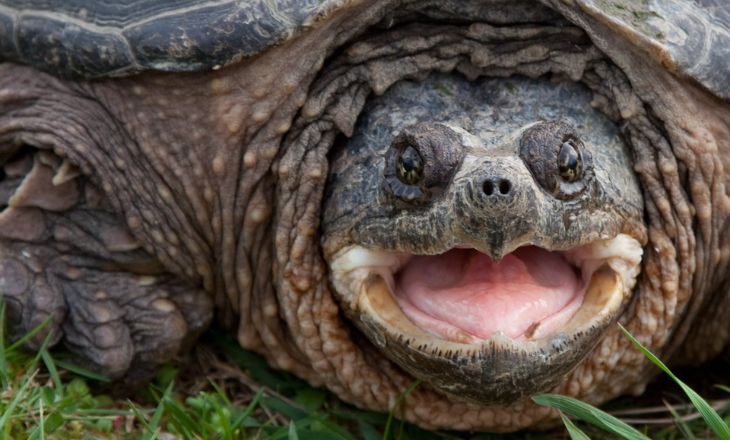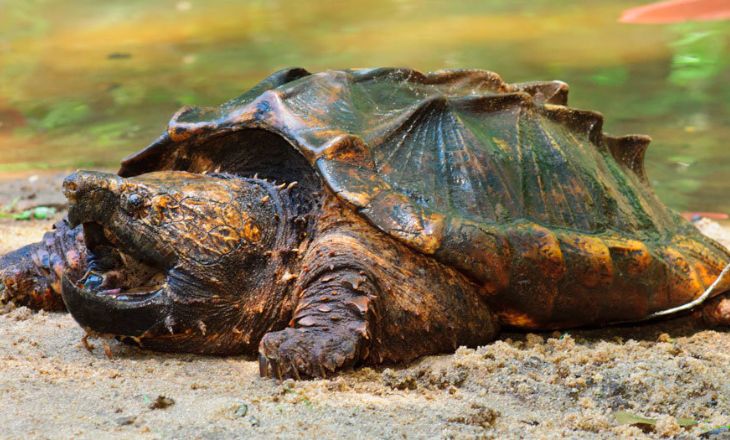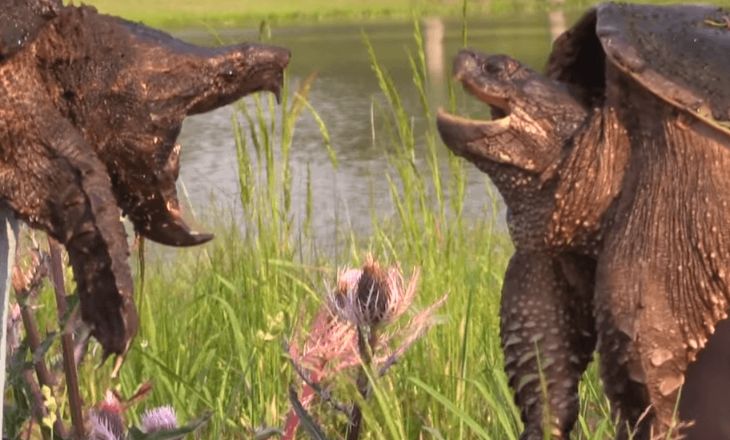The snapping turtle is a strong animal that lives in freshwater areas in North America. It looks ancient and has powerful jaws, making it a top predator in ponds, lakes, and slow rivers. This old reptile is known for being aggressive and big.
With its tough shell and sharp jaws, it can bite hard. The turtle is both graceful and dangerous, able to snap quickly when in danger. It helps keep the balance in its watery homes.
Snapping Turtle History
They are very old animals that have been on Earth for millions of years. Fossils show that they have not changed much since prehistoric times. They have survived changes in the environment, showing they can adapt.
Turtles are important in many indigenous cultures around the world. This shows that people have respected turtles for a long time, not just as reptiles. Studying their history helps us learn about how they have changed over time and how humans are connected to nature.
Snapping Turtle Mouth
It is famous for its strong mouth, which is used for hunting and protection. Its jaws are sharp and powerful, allowing it to catch fish, frogs, and small animals.
When it attacks, the shape of its mouth helps create a vacuum to catch prey easily. They can quickly extend their necks and close their jaws fast to surprise their prey.
Inside its mouth are sharp edges that help tear food. The mouth is a great example of how nature helps animals survive and adapt over time.

Common Snapping Turtle Scientific Name
The common snapping turtle‘s scientific name is Chelydra serpentina. It has a pointed beak and is aggressive, making it a strong predator. The name Chelydra comes from Greek words meaning tortoise-like, referring to its shell.
Snapping Turtle Characteristics
They are unique creatures with strong jaws that can bite quickly when in danger. Their shell, with rough ridges and spikes, protects them and helps them blend in with their surroundings.
They can stay underwater for a long time, using their snorkel-like noses to breathe while hunting for food. They are slow on land but fast swimmers and skilled hunters in the water, eating fish, frogs, and small birds.
Snapping Turtle Lifespan
They are interesting creatures that can live a long time. They have strong shells and can live for over 100 years in the wild. It takes them up to 15 years to grow up, and they keep growing as they get older. This slow growth helps them live a long time and adapt to different environments.
Common Turtle Weight
They are cool animals with a unique look and strong jaws. They can get pretty heavy, with adults weighing between 10 and 35 pounds, and sometimes even up to 50 pounds. This weight is important for their protection from enemies, their ability to stay underwater, and their ability to reproduce and live a long life.
Common Snapping Turtle Diet
They are powerful predators that eat a variety of plants and animals. They consume aquatic plants, insects, fish, frogs, small mammals, and carrion. Their strong jaws can crush shells and bones, making them effective hunters in water.
Older turtles eat more plants, while younger ones prefer meat. They use special hunting techniques like hiding in mud or sand to catch prey.
They have a keen sense of smell to locate food in murky water. They can adjust their diet depending on what’s around them, which helps them thrive in various environments. In general, they are adaptable predators in freshwater habitats.
Turtles Behavior
They are aggressive and can snap their jaws shut with great force to catch prey or scare off predators. They are patient hunters, waiting underwater for hours before attacking their meal.
Snapping Turtle Size
Snapping comes in different sizes based on age and species. The common snapping turtle can grow up to 18 inches long and weigh about 35 pounds.
Snapping Turtles Speed
They may seem slow on land, but they are fast swimmers. They can move quickly to escape danger or catch prey. Their streamlined bodies help them move easily through water, making them efficient hunters. It’s interesting how these turtles, despite looking slow, can be powerful and fast underwater. So, if you see a turtle in the wild, remember that it can move quickly when it needs to.
Largest Snapping Turtle
It is a big turtle with strong jaws. It is one of the largest turtle species. They are often found in freshwater habitats in North America. Despite looking scary, turtles help keep ecosystems healthy by eating fish, insects, and small mammals.

Turtle Bite
The turtle has a strong bite that can hurt people and animals. It has sharp beaks and powerful jaws that can cut through flesh and bone easily. Even though they are slow on land, they can quickly snap at prey or threats. Their jaw structure lets them crush like a crocodile. Once they bite something, they usually don’t let go until they feel safe.
Snapping Turtle Bite Force PSI
They have strong bites that can crush shells, bones, and plants easily. Their bite force is one of the strongest among turtles, making them fierce predators in water. Their bite force is even stronger than wolves and hyenas, showing how good they are at catching prey.
With their strong bite, they can protect themselves and scare off enemies. Nature has given them a powerful weapon for survival in the wild.
Is Tortoise Bite Harmful
Turtle bites are harmful because of their strong jaws and sharp beaks used for catching prey. Their bites can cause deep wounds that may need medical care to prevent infection. It’s important to be careful around turtles and not make them feel threatened, as they can become aggressive.
Turtles Eggs
Turtle eggs are important for turtle reproduction but face many threats today. Mother turtles work hard to lay eggs and protect them, but environmental issues like habitat loss and climate change make it tough for eggs to hatch.
Turtles have evolved in unique ways over millions of years to help their babies survive, like burying eggs deep in the sand.
Human activities, like building near beaches and pollution, harm turtle eggs. It’s crucial to protect turtle eggs to keep these amazing animals alive. By supporting conservation and spreading awareness, we can help turtles thrive and keep the oceans healthy. Each turtle egg is a sign of hope for the future – let’s work together to protect them.
Alligator Snapping Turtle vs Common Snapping Turtle
The difference between the Alligator Snapping Turtle and the Common Snapping Turtle lies not only in their appearance but also in their behaviour.
While both are formidable predators, the Alligator Snapping Turtle is known for its larger size and more aggressive nature. This ancient reptile, with its sharp beak and powerful jaws, can weigh up to 200 pounds and has been known to snap off broom handles with a single bite.
The discovery of a 405 pound alligator snapping turtle has left scientists and reptile enthusiasts in awe.
The Common Snapping Turtle is smaller in size but no less fierce. With its distinctive serrated shell and long tail, this turtle is a skilled hunter who uses clever ambush tactics to catch prey.
Despite their differences, both species play important roles in their ecosystems as top predators, helping maintain balance in aquatic environments.
Whether it’s the massive strength of the Alligator Snapping Turtle or the cunning tactics of the Common Snapping Turtle, these creatures showcase nature’s diversity at its finest.

Baby Alligator Snapping Turtle
The Baby Alligator Snapping Turtle is small but strong and agile. It has sharp jaws that can deliver a powerful bite, making it a strong predator even when young. Despite looking scary, these baby turtles are important for their ecosystem.
As they grow, they develop unique patterns on their shells for camouflage. This helps them blend in and catch prey easily. Watching a baby Alligator Snapping Turtle move gracefully in water is amazing and shows the beauty of nature.
These baby turtles are fascinating creatures with unique abilities. Learning about them helps us understand the natural world better.
Conclusion
The snapping turtle is a formidable and fascinating creature that commands respect in its natural habitat. With its large size, powerful jaws, and unique shell design, this species is well-adapted for survival in both water and land environments.
Its diet of fish, insects, plants, and even carrion showcases its versatility as an opportunistic feeder. Despite facing threats from habitat loss and human interference, turtles continue to thrive in many regions.
We need to appreciate and protect these ancient reptiles to ensure their continued presence in our ecosystems. Take a moment to learn more about turtles and how you can help conserve their populations for future generations.
Frequently Asked Question
How To Tell If A Snapping Turtle Is Male or Female?
Male and female snapping turtles are similar in size, but you can tell them apart by looking at their tails. Male snapping turtles have longer and thicker tails than females.
Are Snapping Turtles Shy?
The snapping turtle is known for being aggressive on land because people get too close to them. In water, they are shy and try to avoid humans.
How Intelligent Are Snapping Turtles?
One researcher believes that the Snapping Turtle is the smartest type of turtle because it can live in many different places.
What Animal Has 25 IQ?
Studies on chimpanzees suggest that their IQ is similar to that of a human toddler, ranging from 20 to 25. They are skilled at solving problems, such as using sticks to get insects from trees or using leaves to scoop water.

